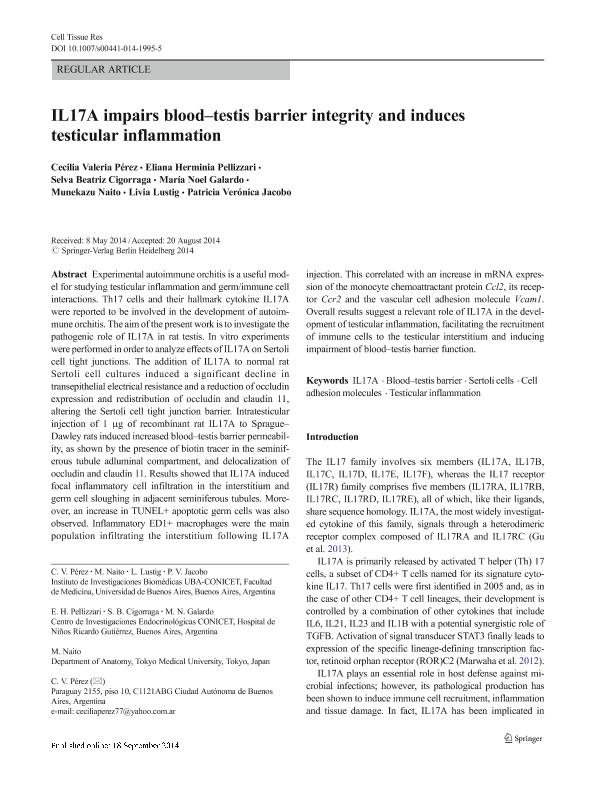Artículo
IL17A impairs blood-testis barrier integrity and induces testicular inflammation
Pérez, Cecilia Valeria ; Pellizzari, Eliana Herminia
; Pellizzari, Eliana Herminia ; Cigorraga, Selva Beatriz
; Cigorraga, Selva Beatriz ; Galardo, Maria Noel Lujan
; Galardo, Maria Noel Lujan ; Naito, Munekazu; Lustig, Livia
; Naito, Munekazu; Lustig, Livia ; Jacobo, Patricia Verónica
; Jacobo, Patricia Verónica
 ; Pellizzari, Eliana Herminia
; Pellizzari, Eliana Herminia ; Cigorraga, Selva Beatriz
; Cigorraga, Selva Beatriz ; Galardo, Maria Noel Lujan
; Galardo, Maria Noel Lujan ; Naito, Munekazu; Lustig, Livia
; Naito, Munekazu; Lustig, Livia ; Jacobo, Patricia Verónica
; Jacobo, Patricia Verónica
Fecha de publicación:
09/2014
Editorial:
Springer
Revista:
Cell and Tissue Research
ISSN:
0302-766X
e-ISSN:
1432-0878
Idioma:
Inglés
Tipo de recurso:
Artículo publicado
Clasificación temática:
Resumen
Experimental autoimmune orchitis is a useful model for studying testicular inflammation and germ/immune cell interactions. Th17 cells and their hallmark cytokine IL17A were reported to be involved in the development of autoimmune orchitis. The aim of the present work is to investigate the pathogenic role of IL17A in rat testis. In vitro experiments were performed in order to analyze effects of IL17A on Sertoli cell tight junctions. The addition of IL17A to normal rat Sertoli cell cultures induced a significant decline in transepithelial electrical resistance and a reduction of occludin expression and redistribution of occludin and claudin 11, altering the Sertoli cell tight junction barrier. Intratesticular injection of 1 μg of recombinant rat IL17A to Sprague–Dawley rats induced increased blood–testis barrier permeability, as shown by the presence of biotin tracer in the seminiferous tubule adluminal compartment, and delocalization of occludin and claudin 11. Results showed that IL17A induced focal inflammatory cell infiltration in the interstitium and germ cell sloughing in adjacent seminiferous tubules. Moreover, an increase in TUNEL+ apoptotic germ cells was also observed. Inflammatory ED1+ macrophages were the main population infiltrating the interstitium following IL17A injection. This correlated with an increase in mRNA expression of the monocyte chemoattractant protein Ccl2, its receptor Ccr2 and the vascular cell adhesion molecule Vcam1. Overall results suggest a relevant role of IL17A in the development of testicular inflammation, facilitating the recruitment of immune cells to the testicular interstitium and inducing impairment of blood–testis barrier function.
Archivos asociados
Licencia
Identificadores
Colecciones
Articulos(BIOMED)
Articulos de INSTITUTO DE INVESTIGACIONES BIOMEDICAS
Articulos de INSTITUTO DE INVESTIGACIONES BIOMEDICAS
Articulos(CEDIE)
Articulos de CENTRO DE INVESTIGACIONES ENDOCRINOLOGICAS "DR. CESAR BERGADA"
Articulos de CENTRO DE INVESTIGACIONES ENDOCRINOLOGICAS "DR. CESAR BERGADA"
Articulos(INBIOMED)
Articulos de INSTITUTO DE INVESTIGACIONES BIOMEDICAS
Articulos de INSTITUTO DE INVESTIGACIONES BIOMEDICAS
Citación
Pérez, Cecilia Valeria; Pellizzari, Eliana Herminia; Cigorraga, Selva Beatriz; Galardo, Maria Noel Lujan; Naito, Munekazu; et al.; IL17A impairs blood-testis barrier integrity and induces testicular inflammation; Springer; Cell and Tissue Research; 358; 3; 9-2014; 885-898
Compartir
Altmétricas



